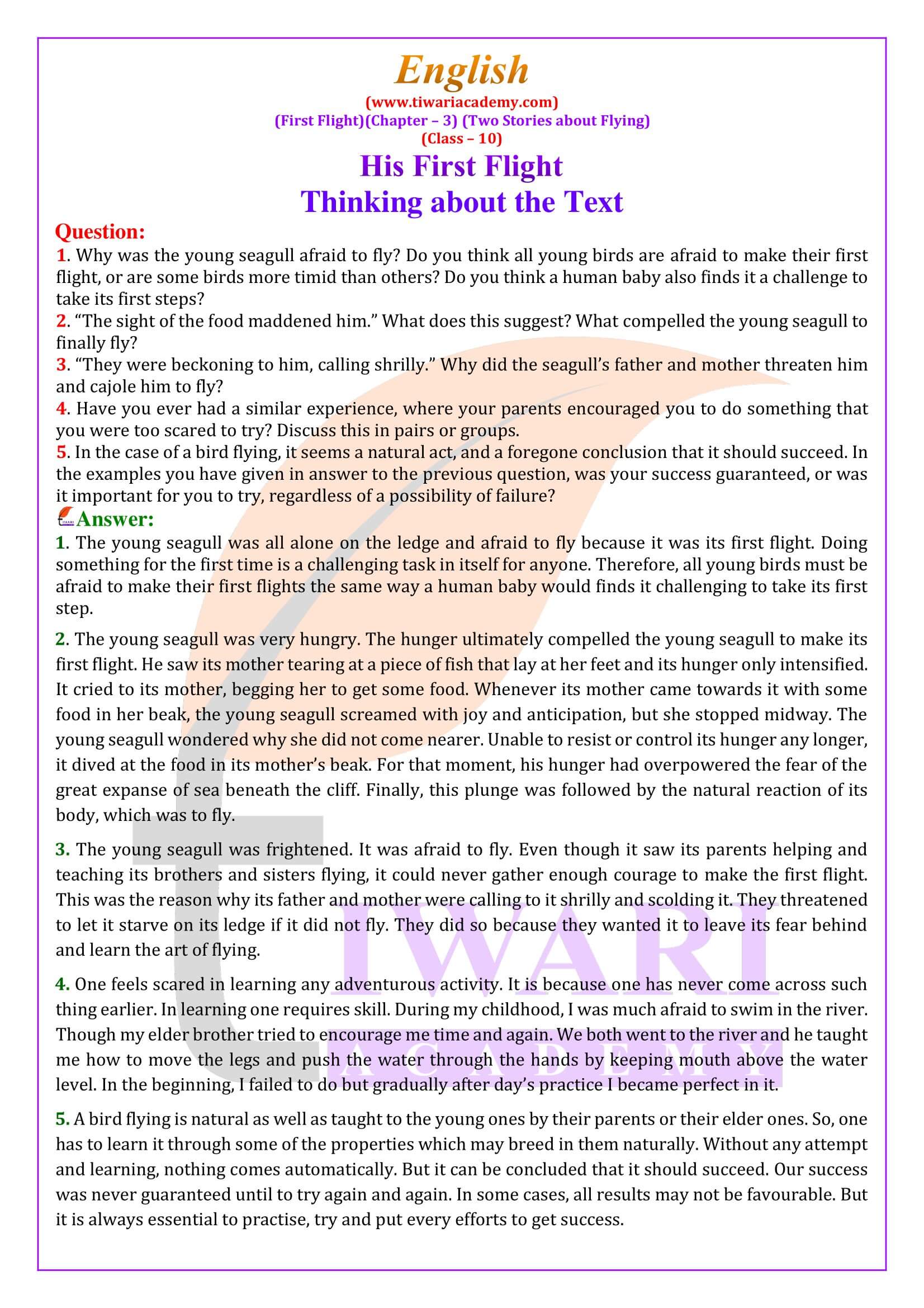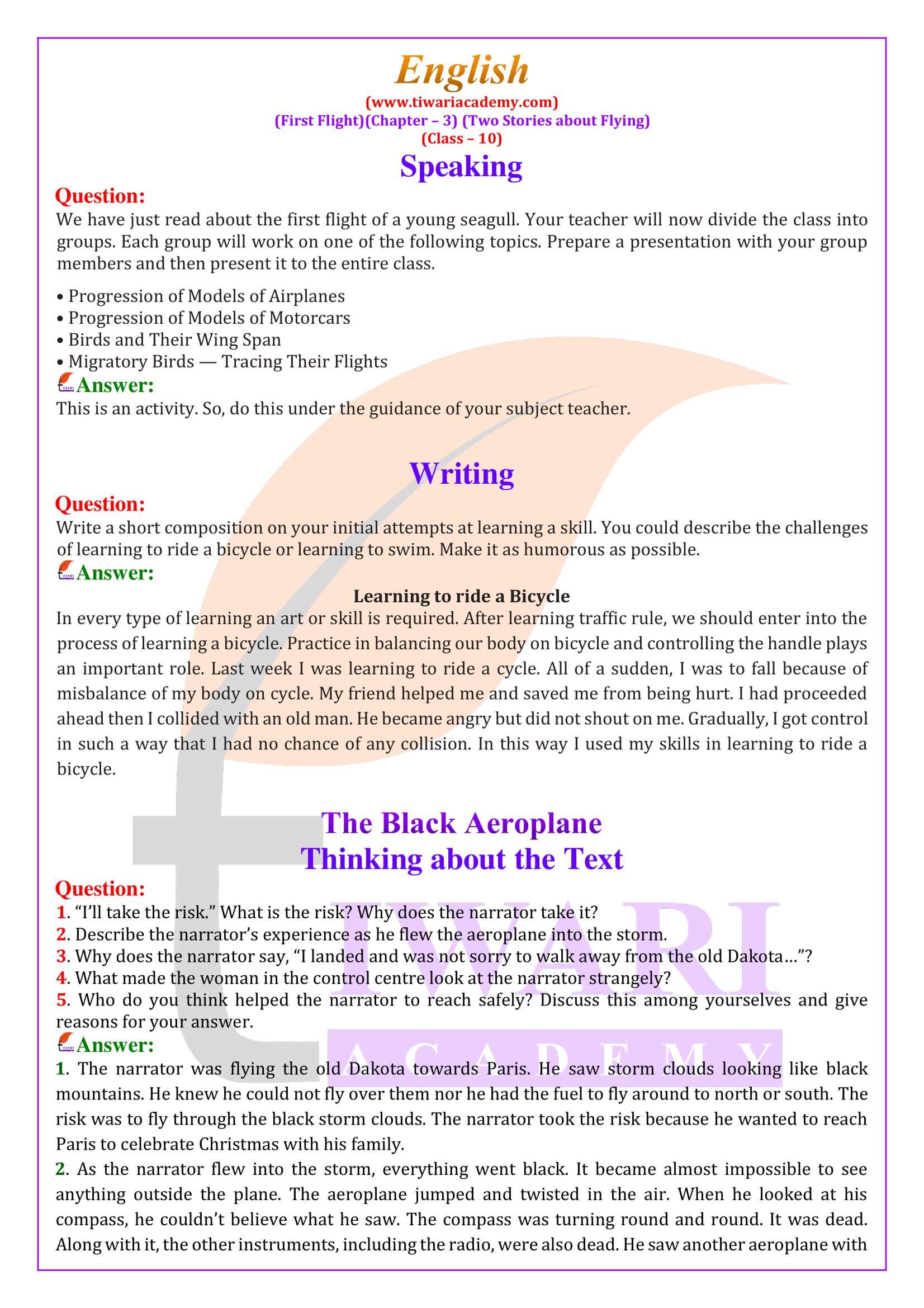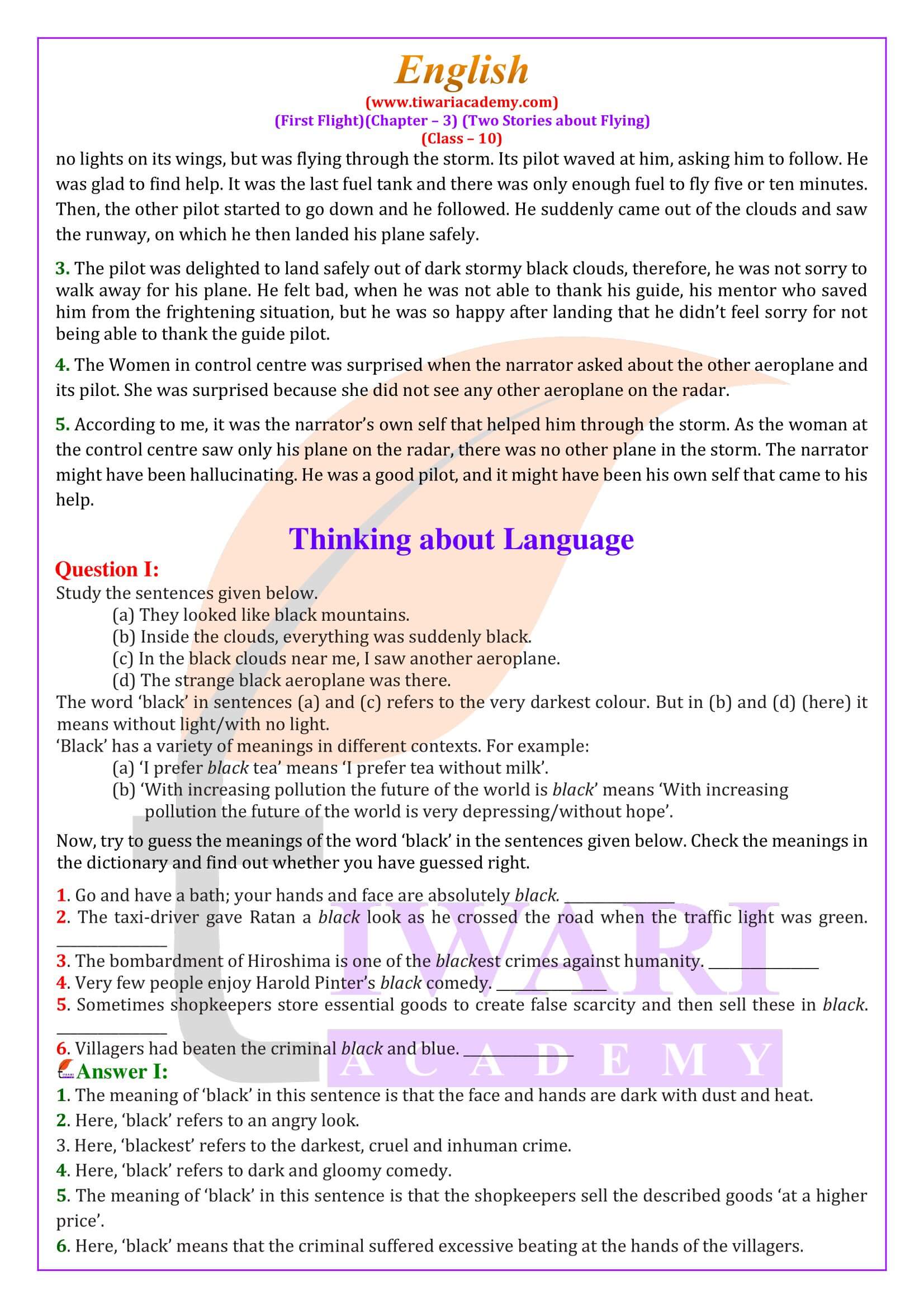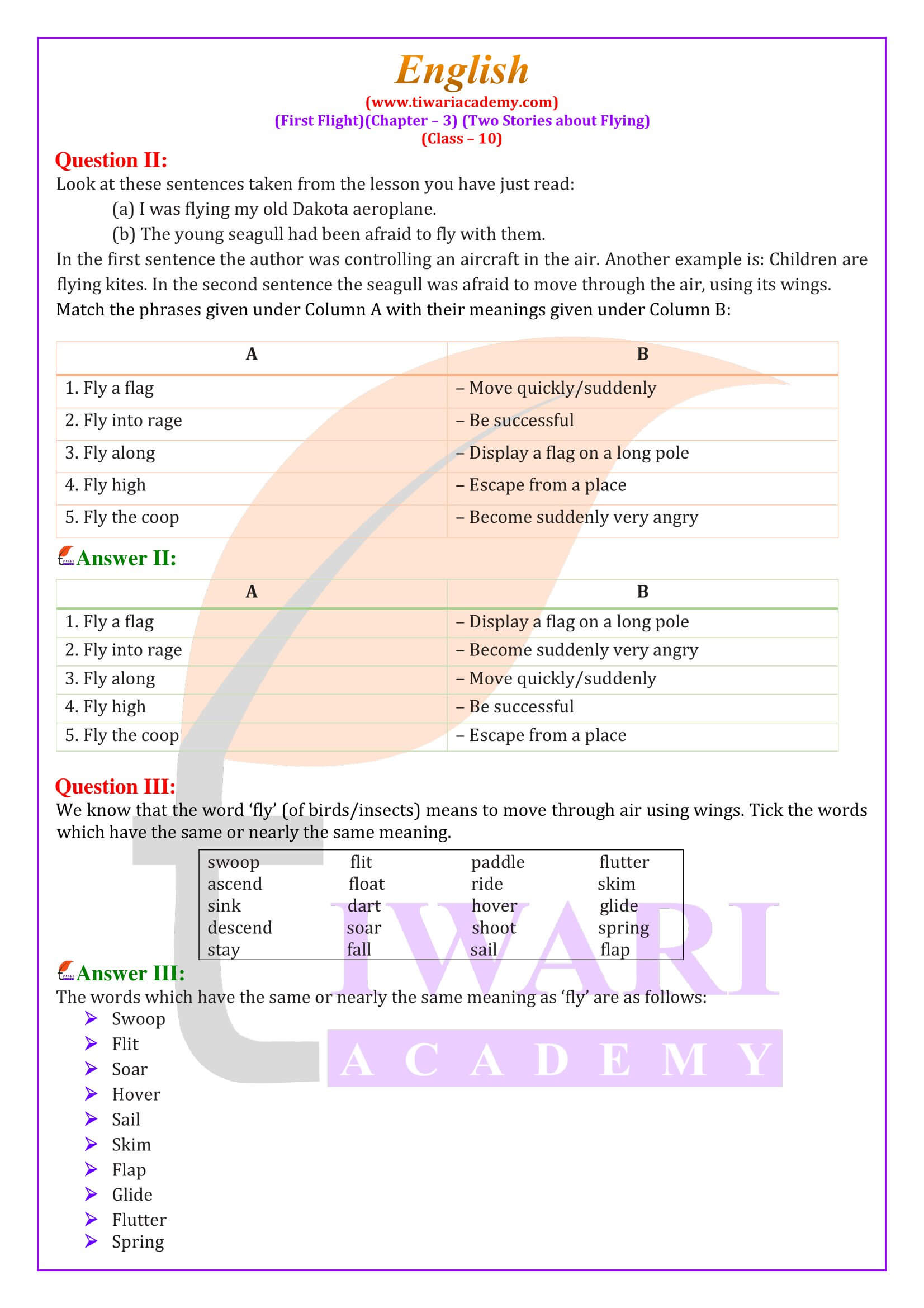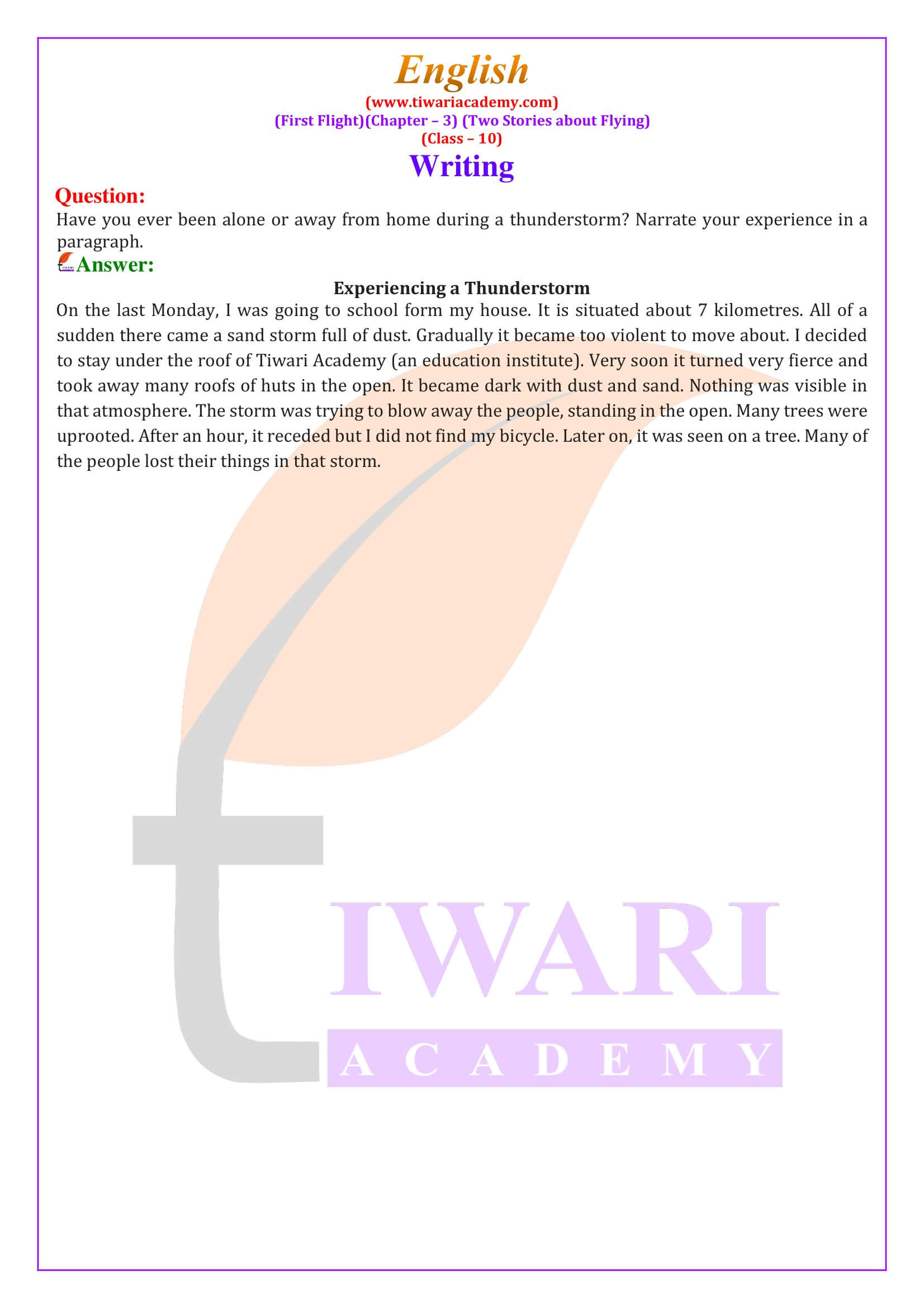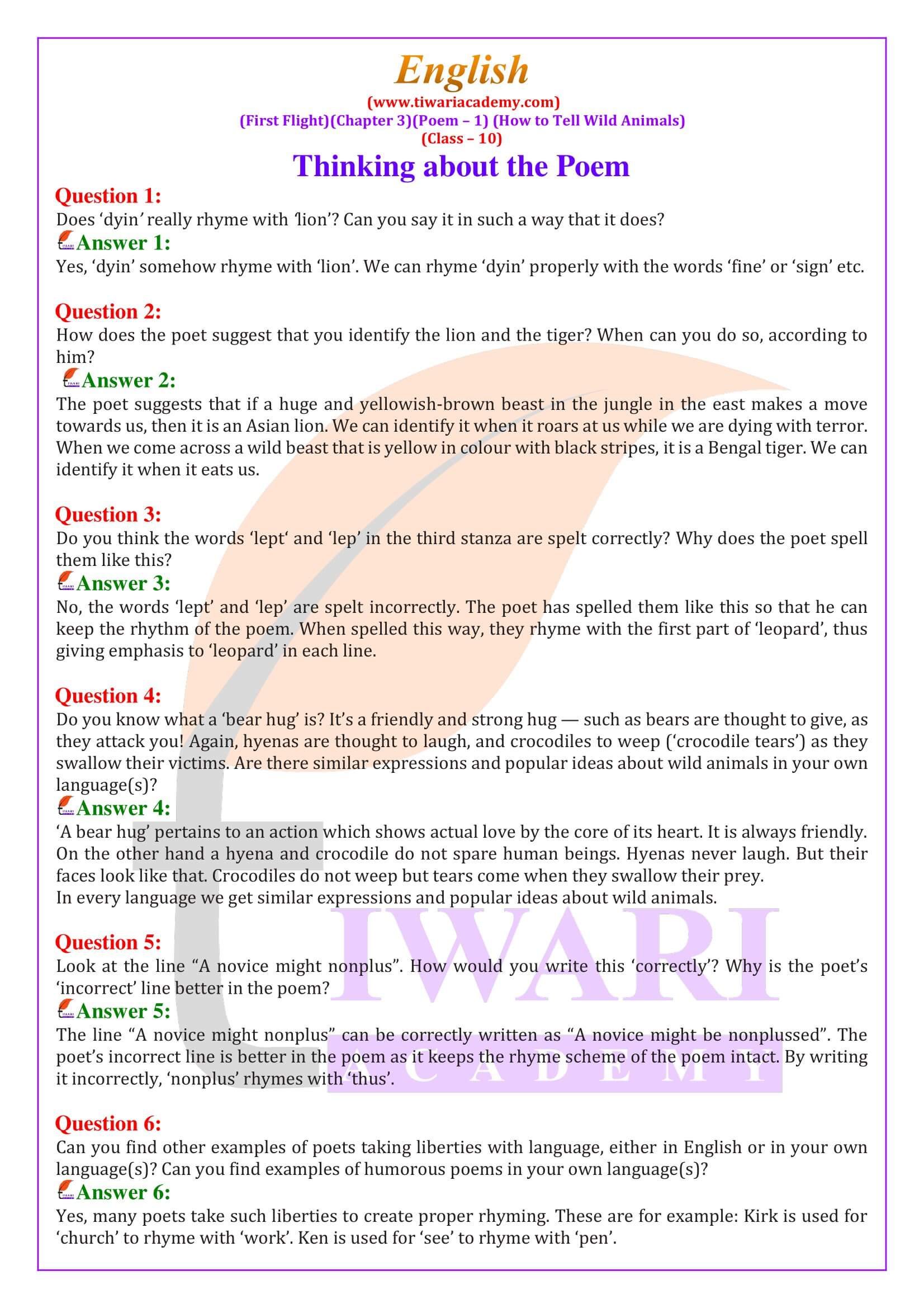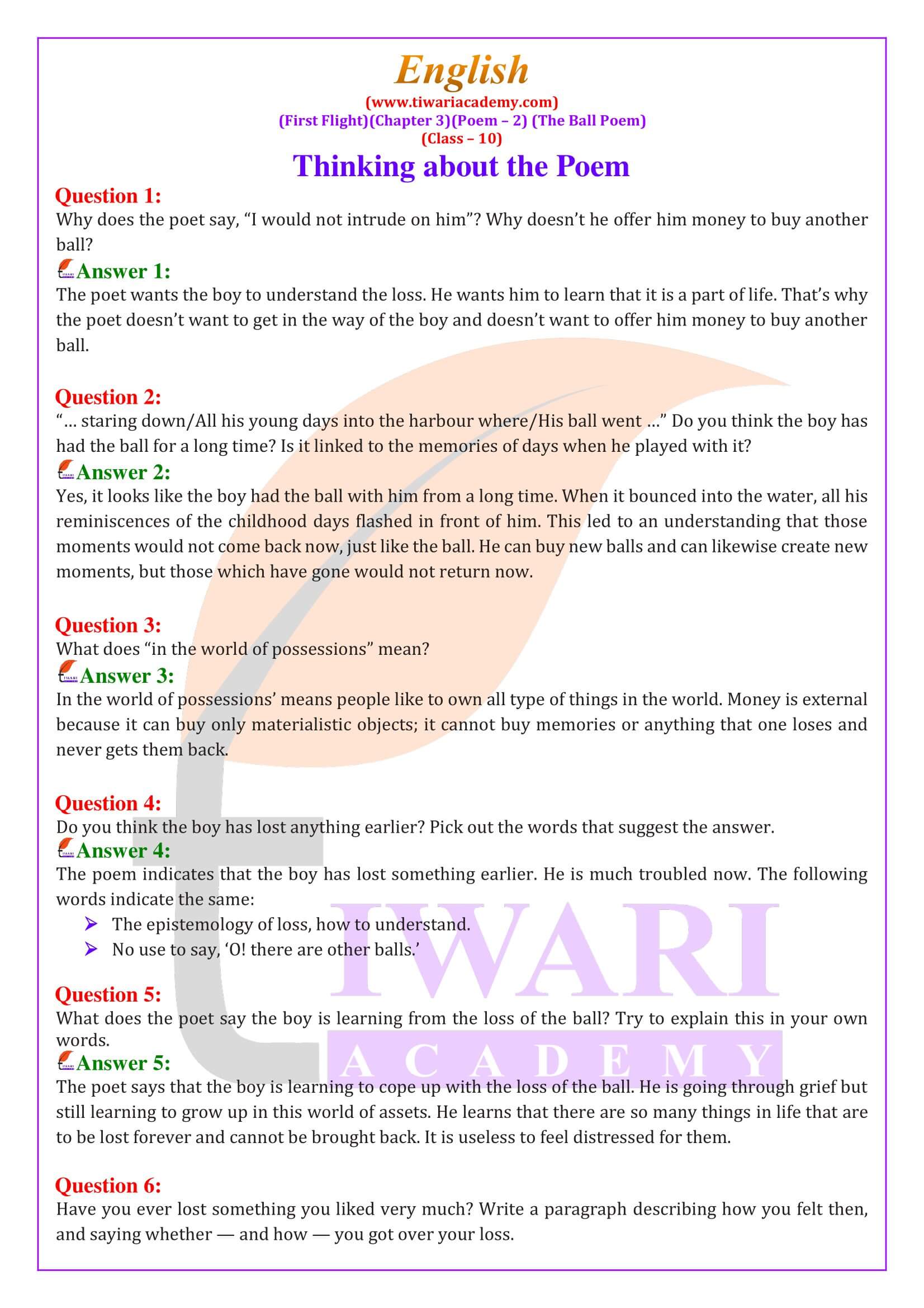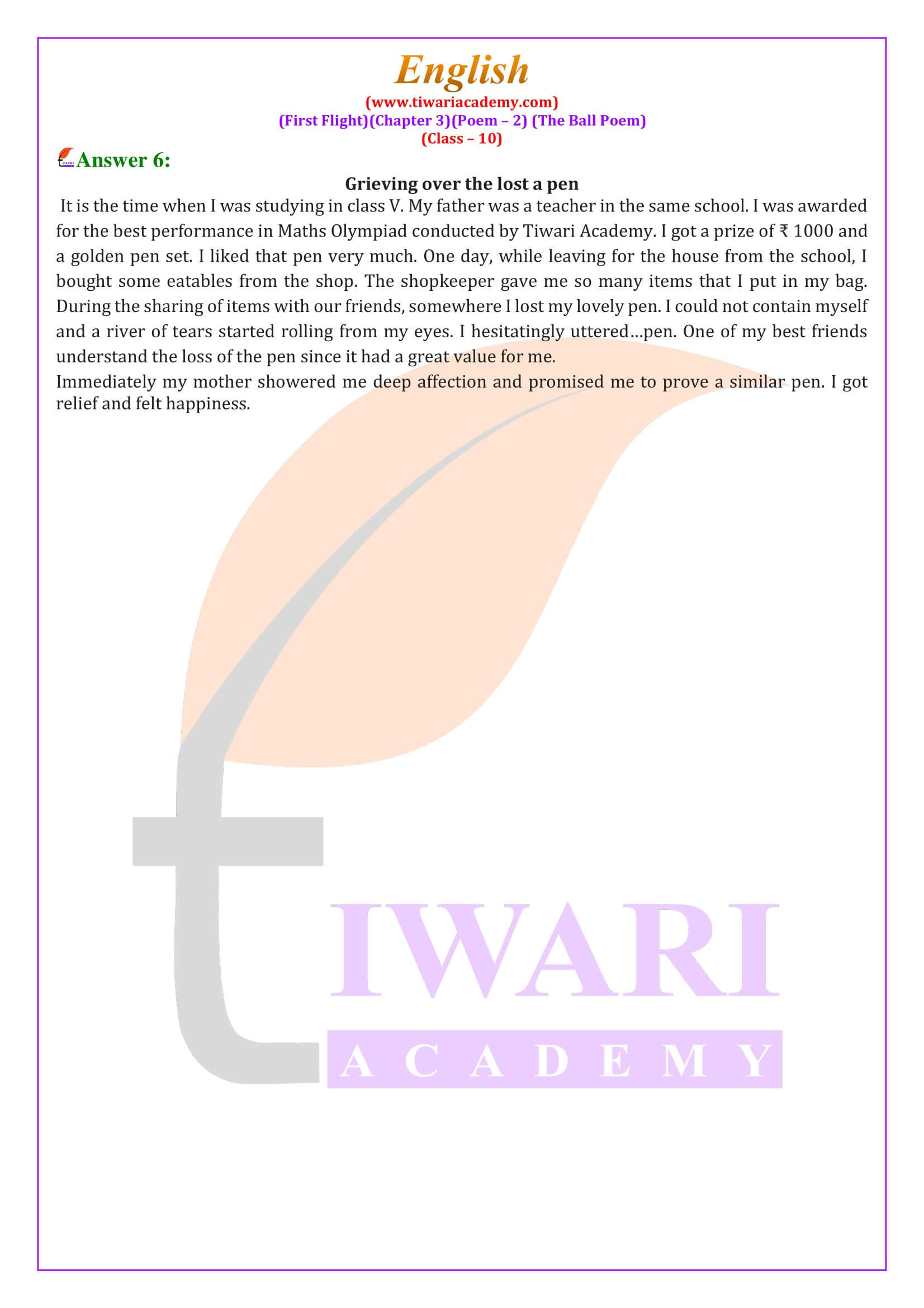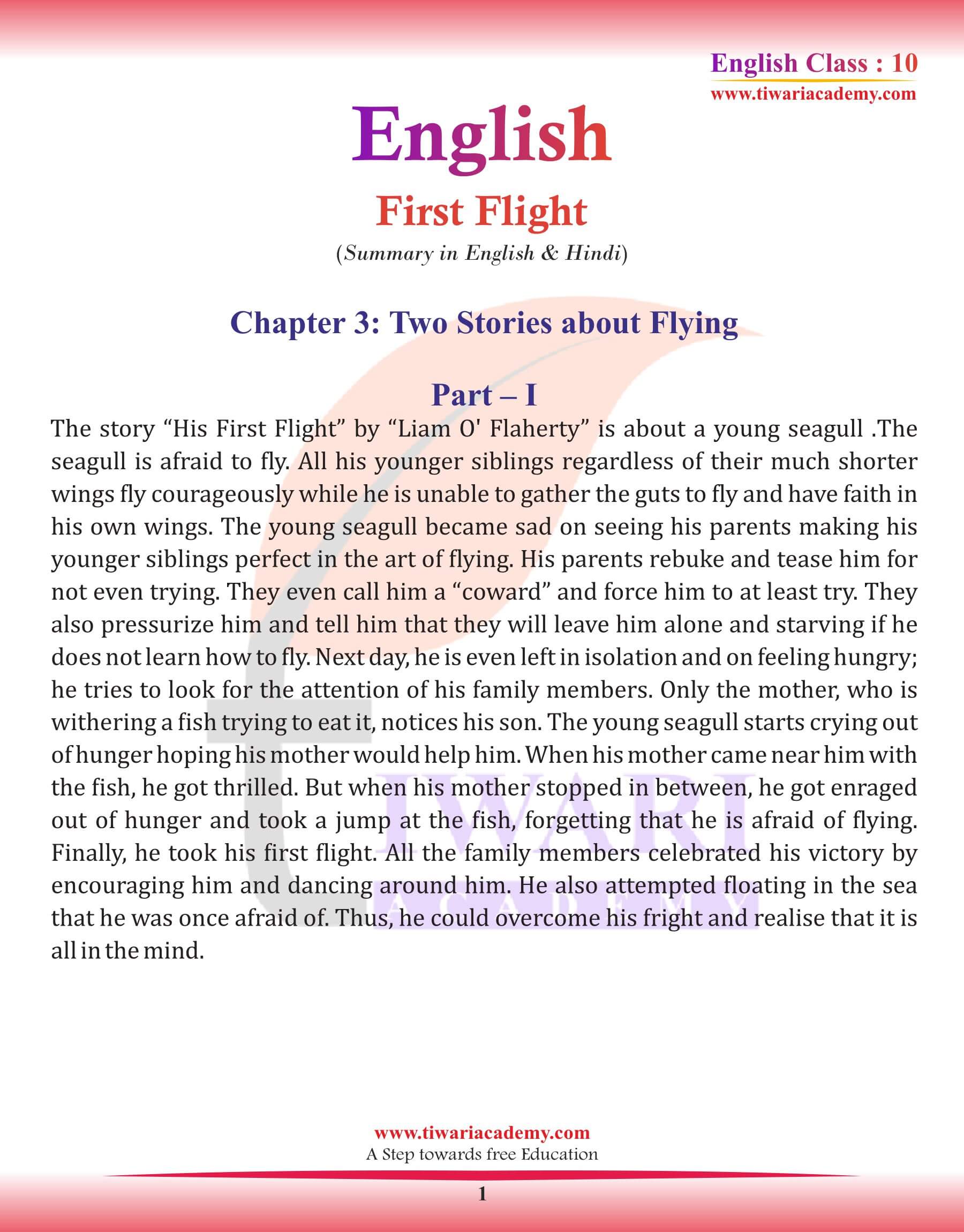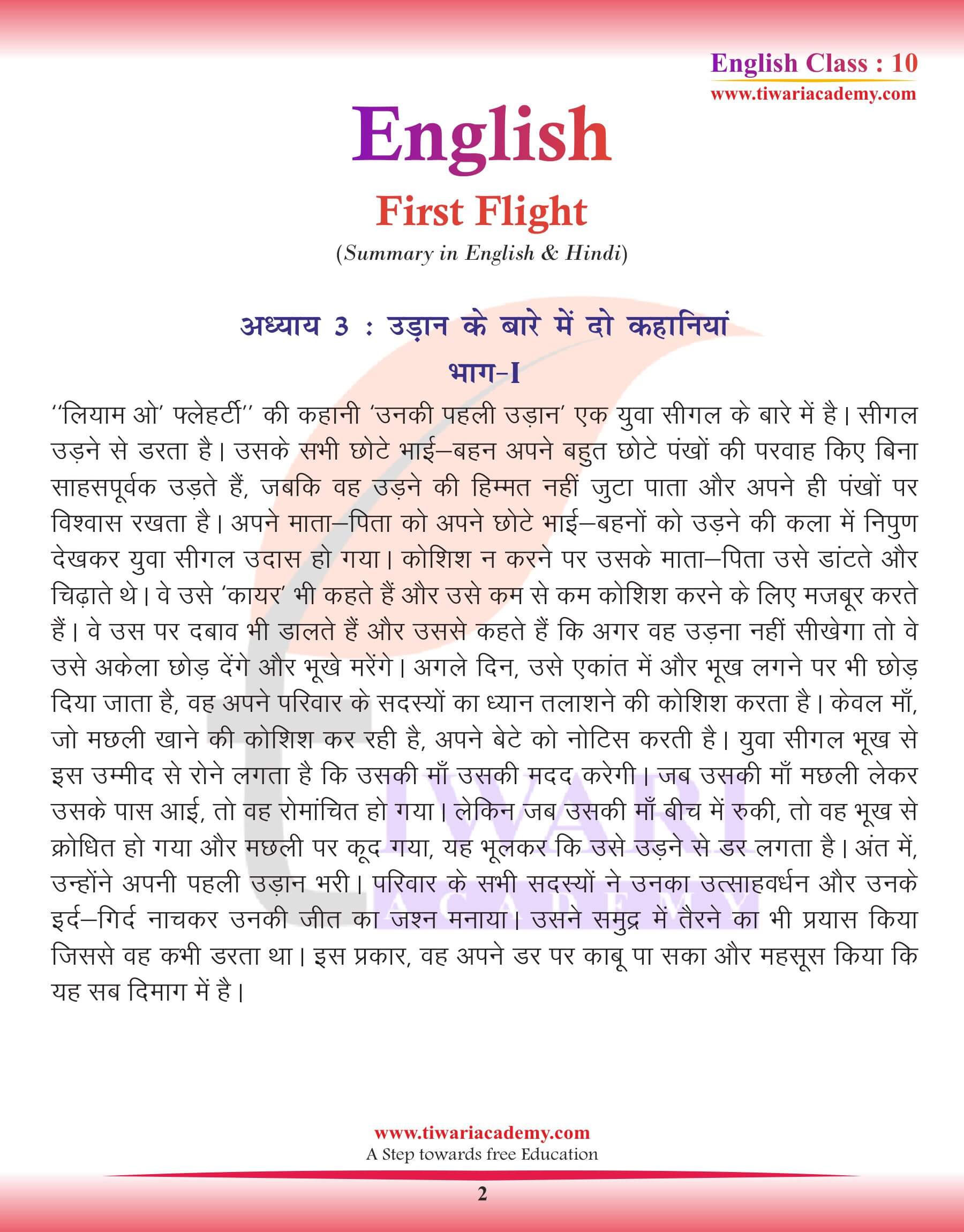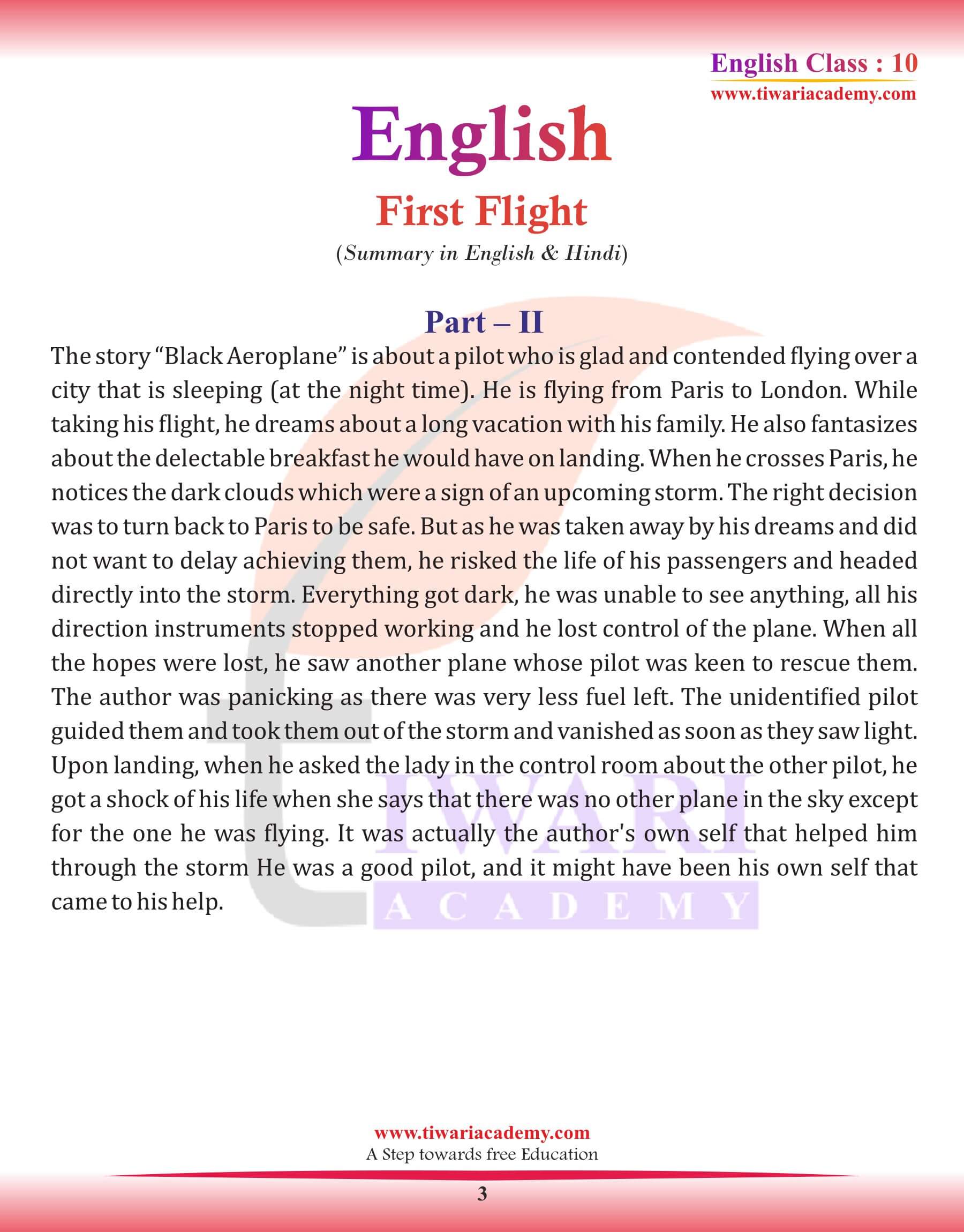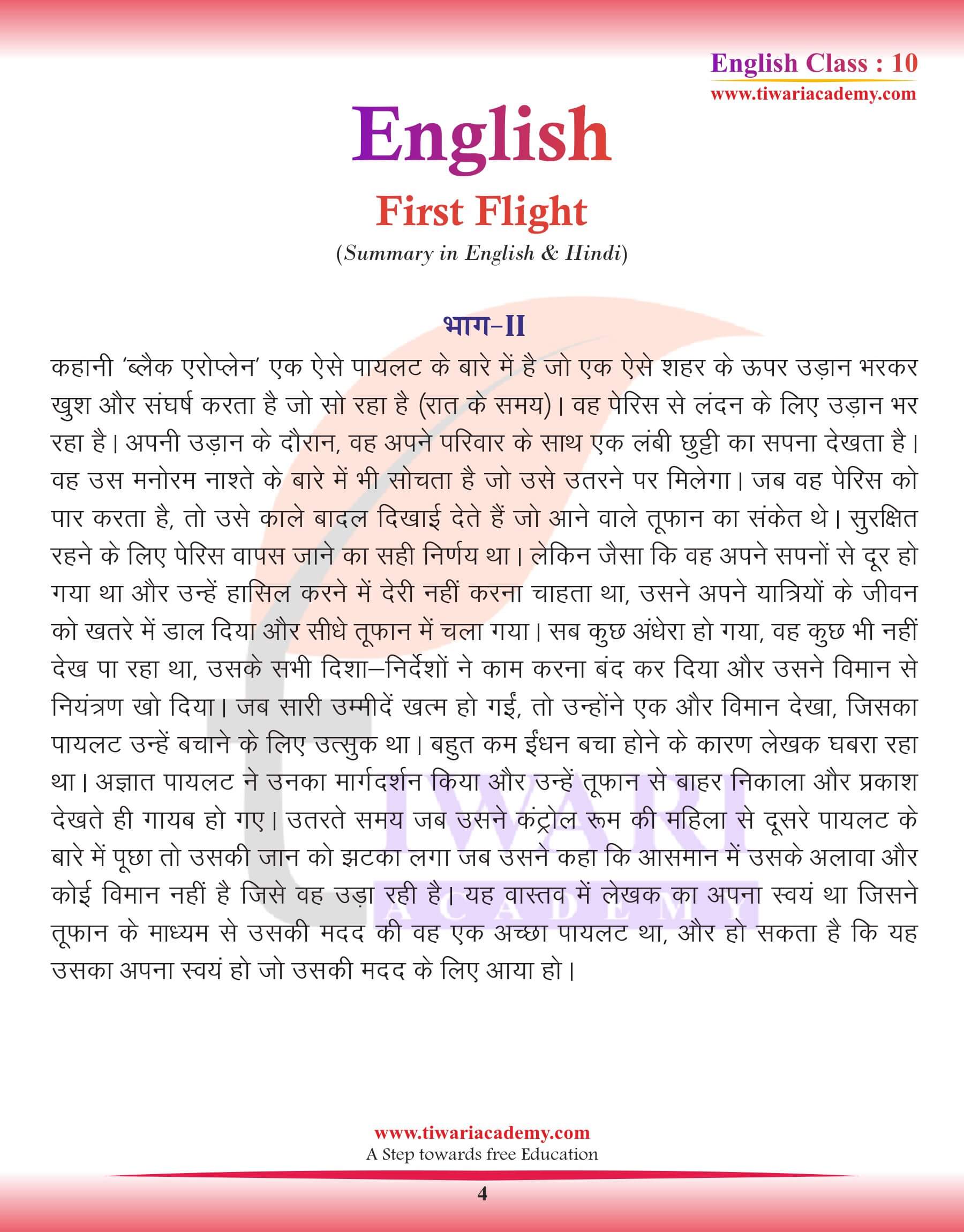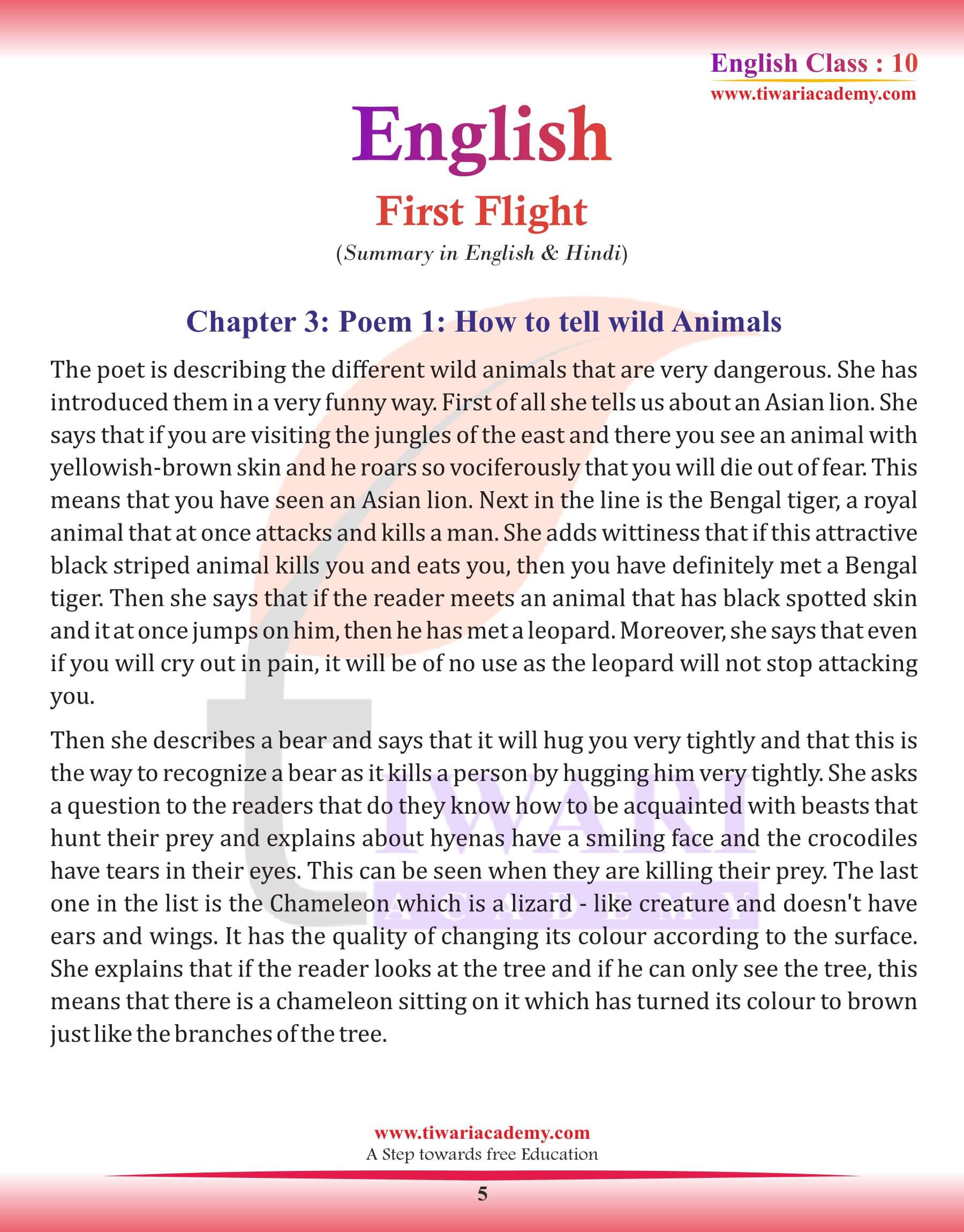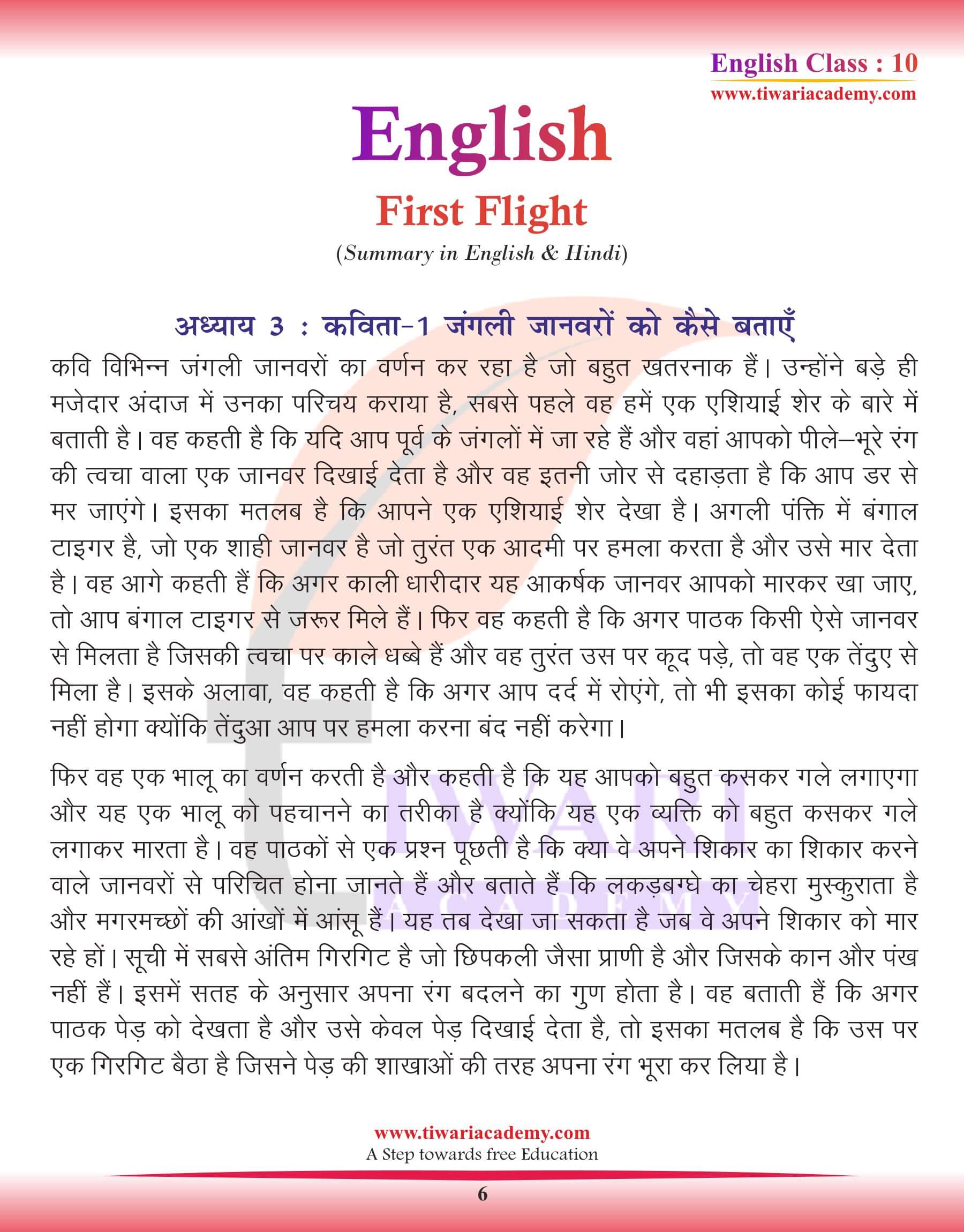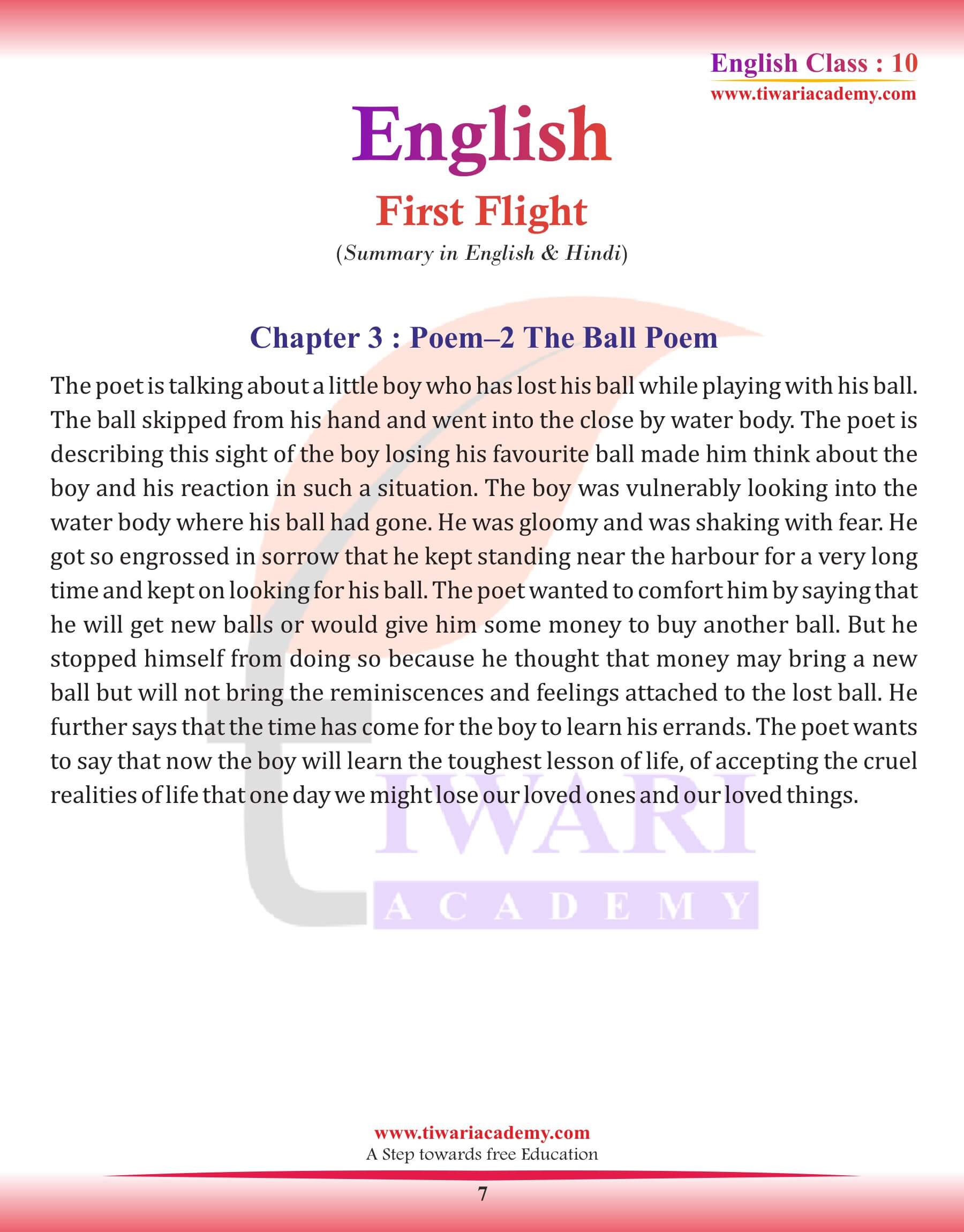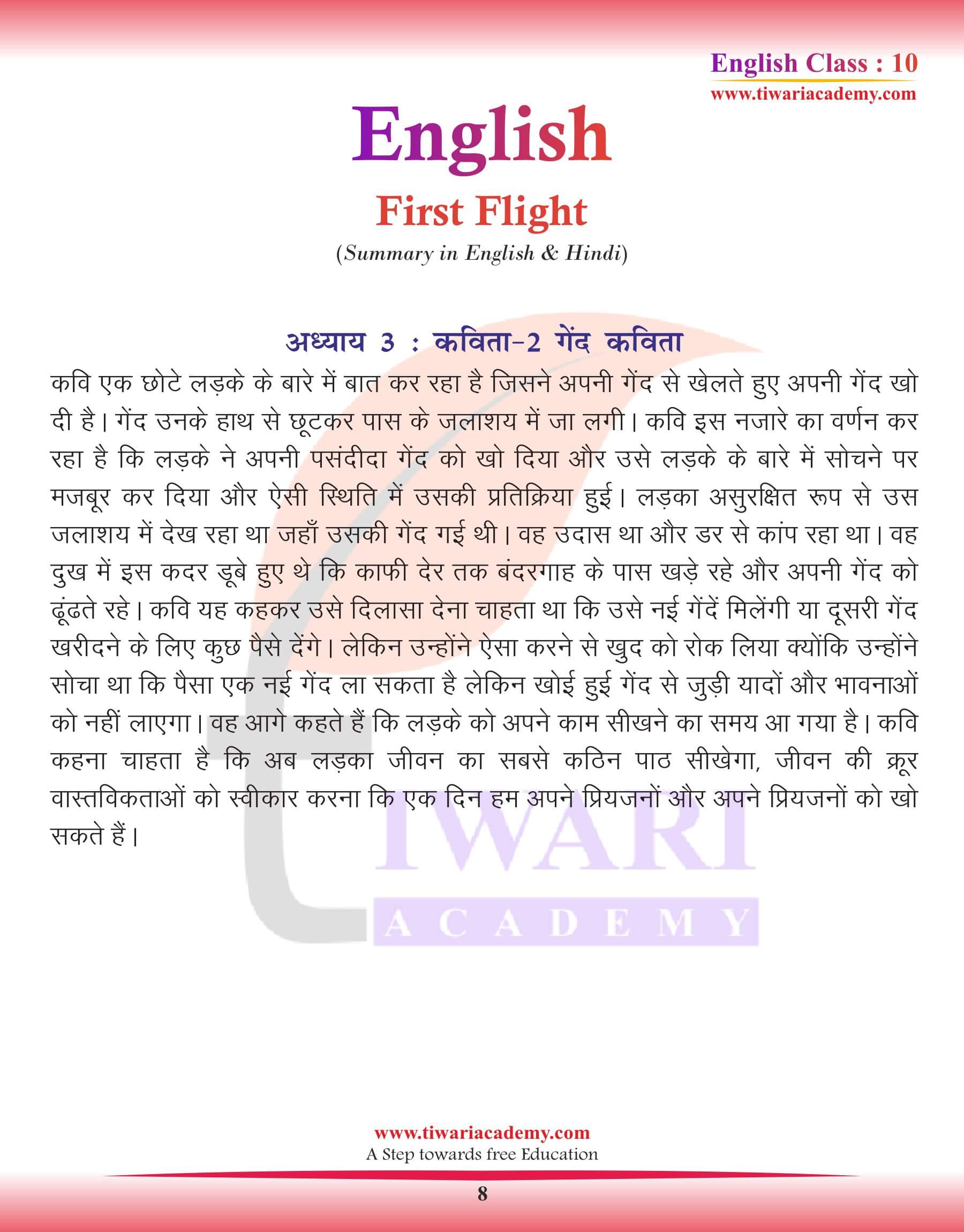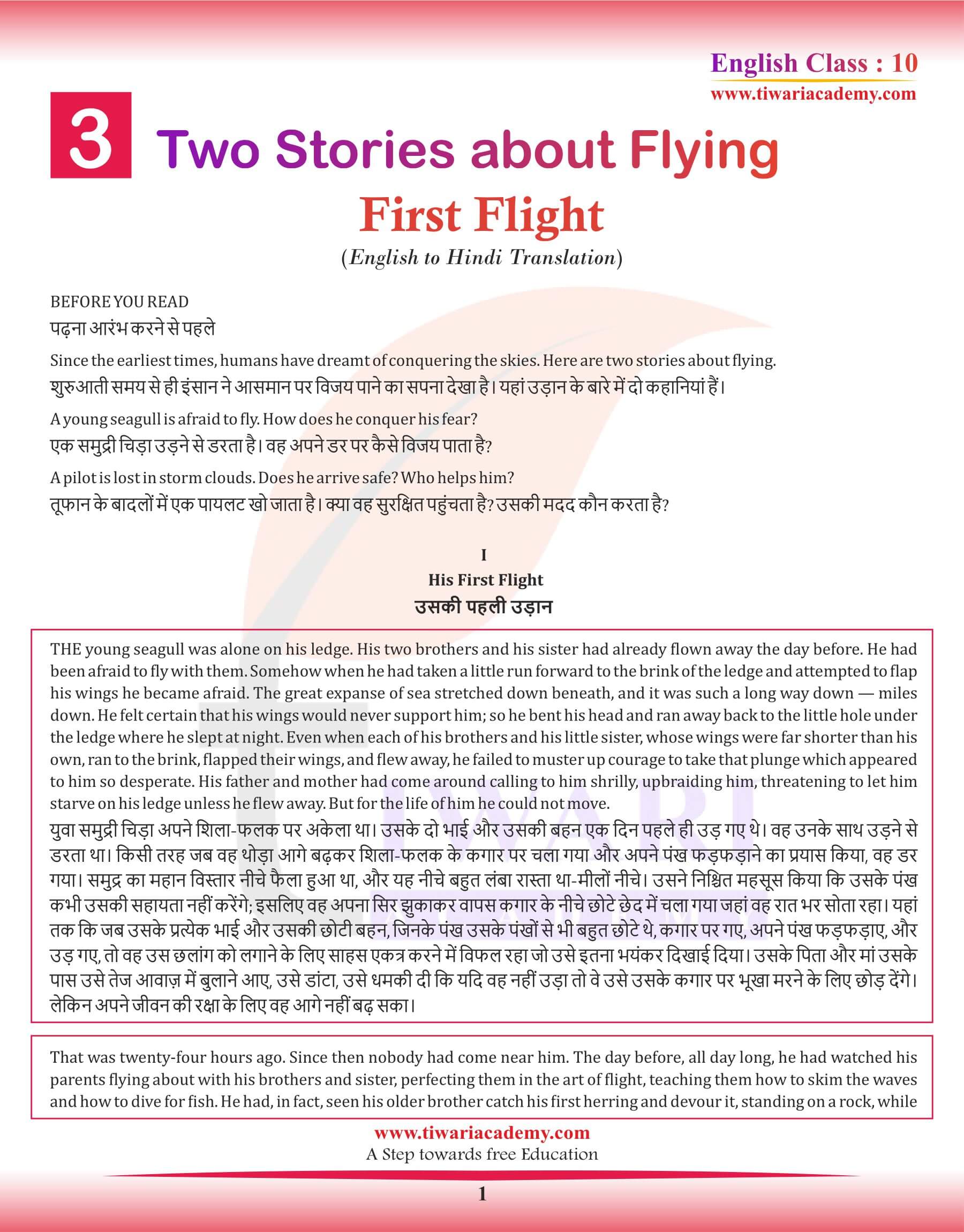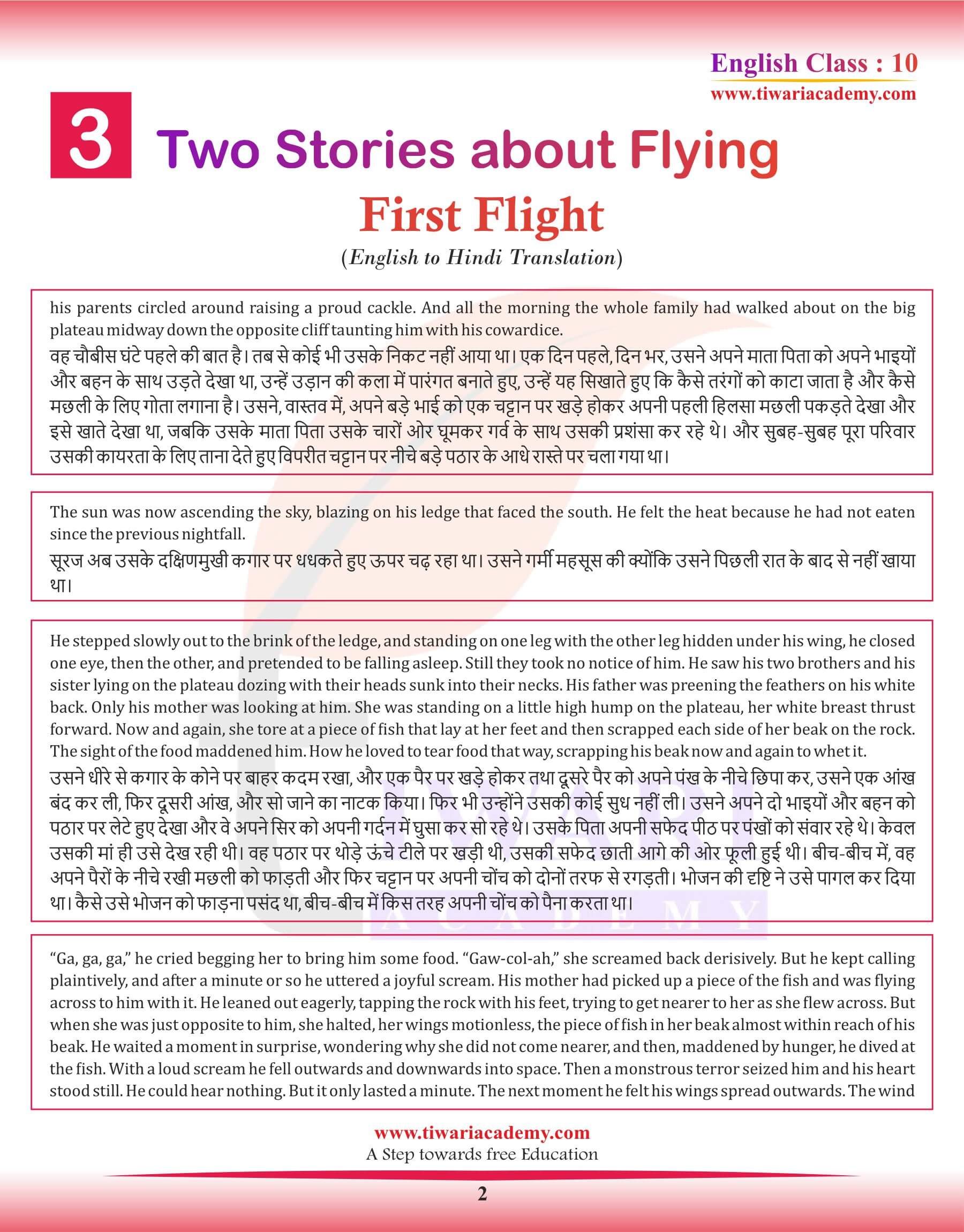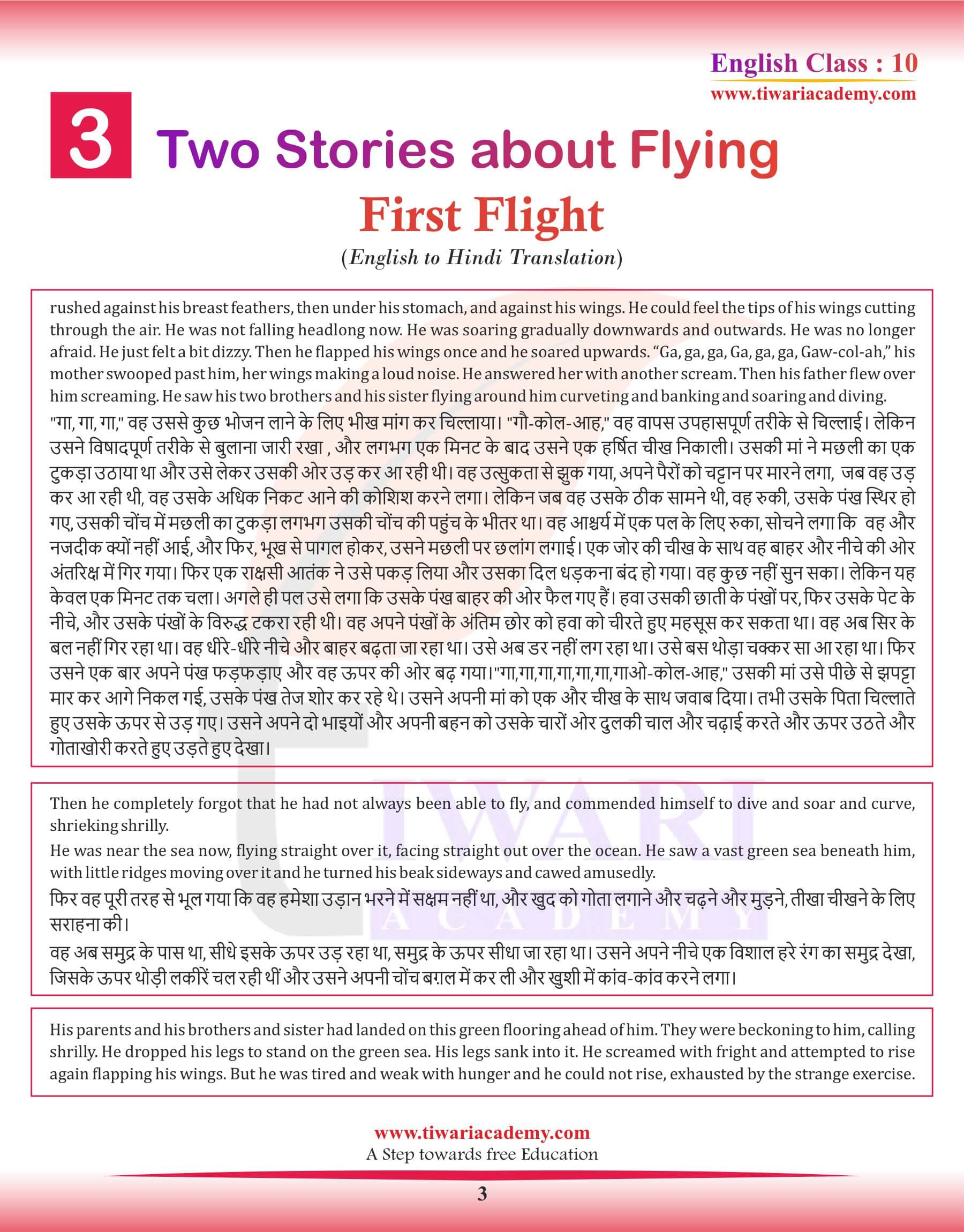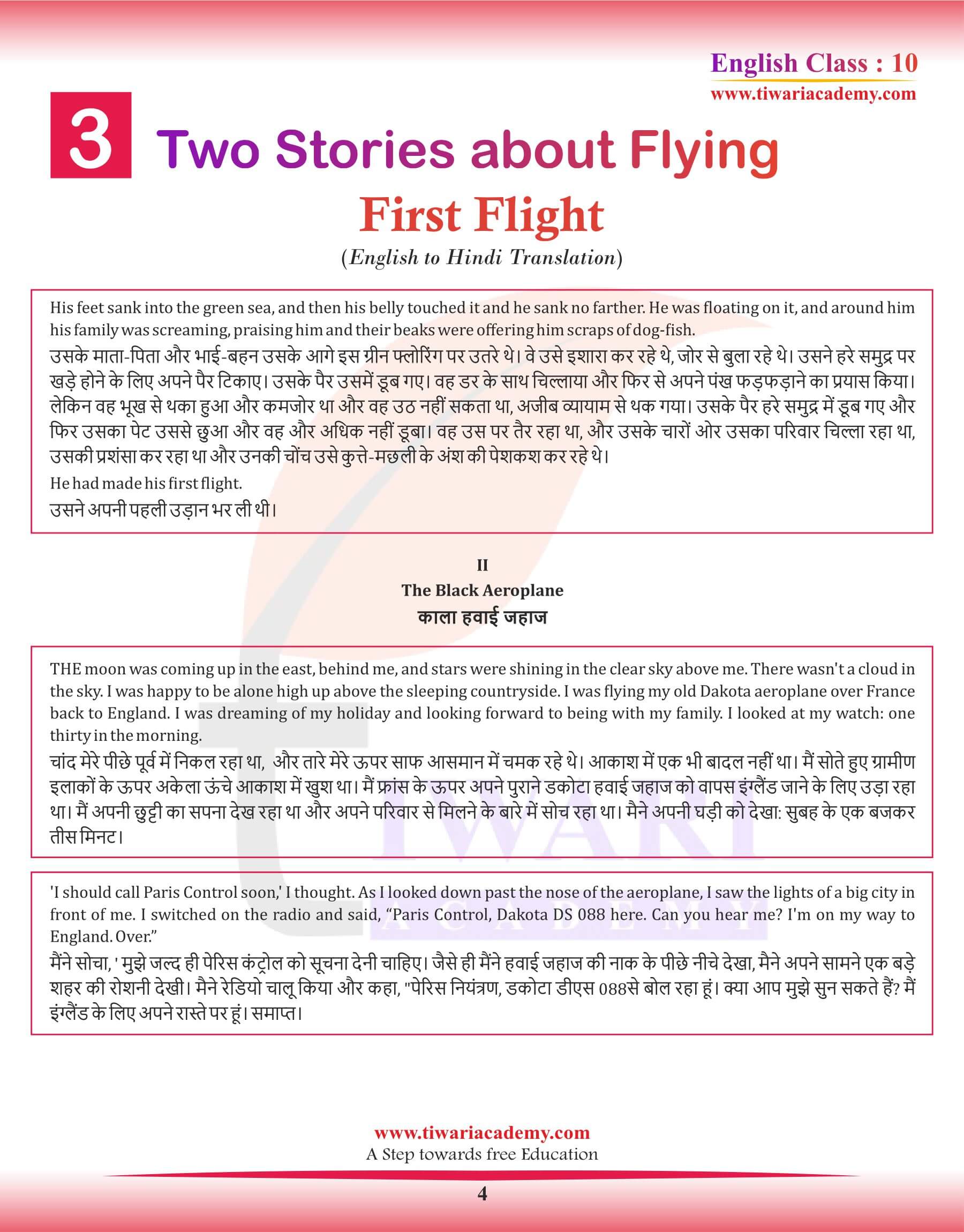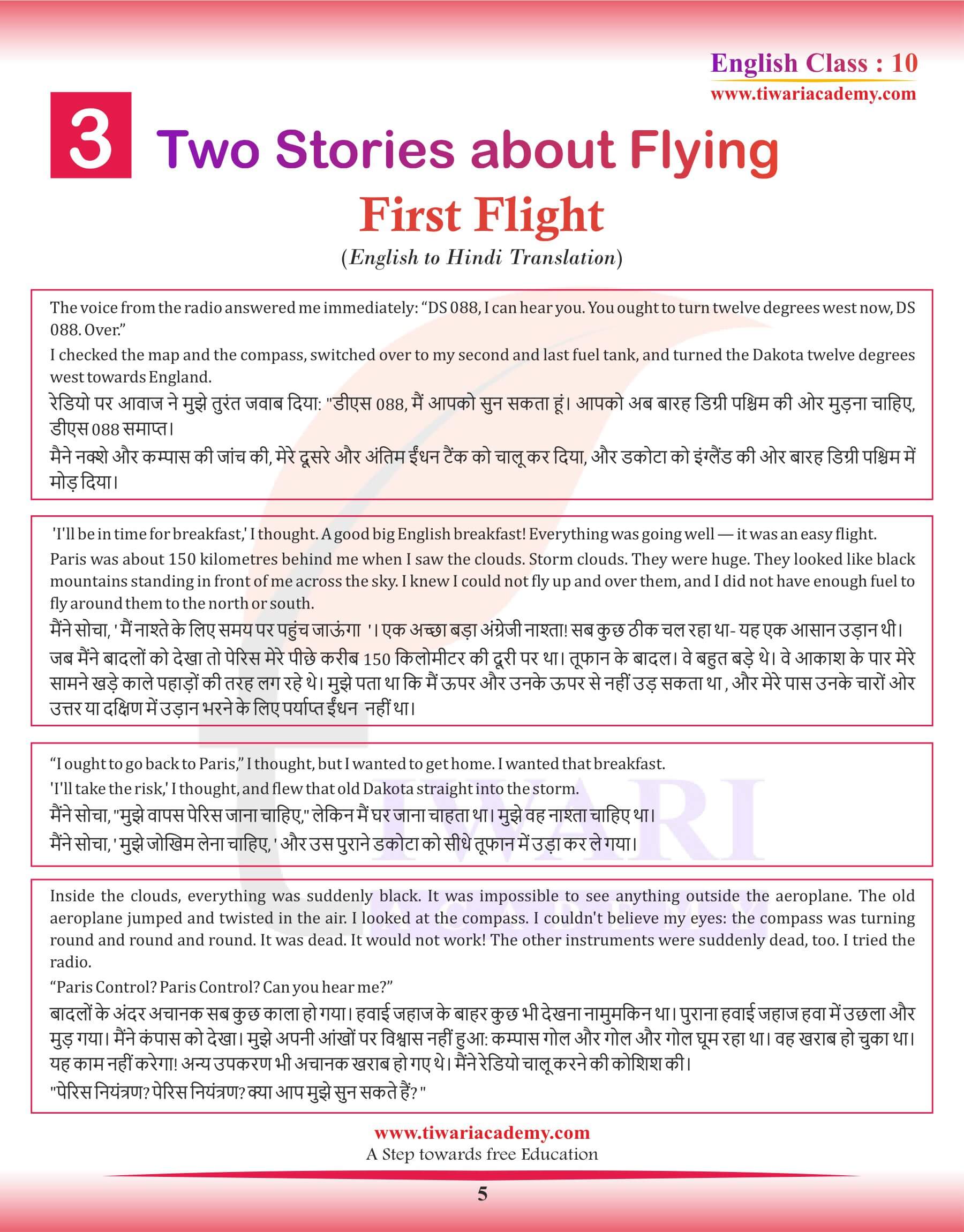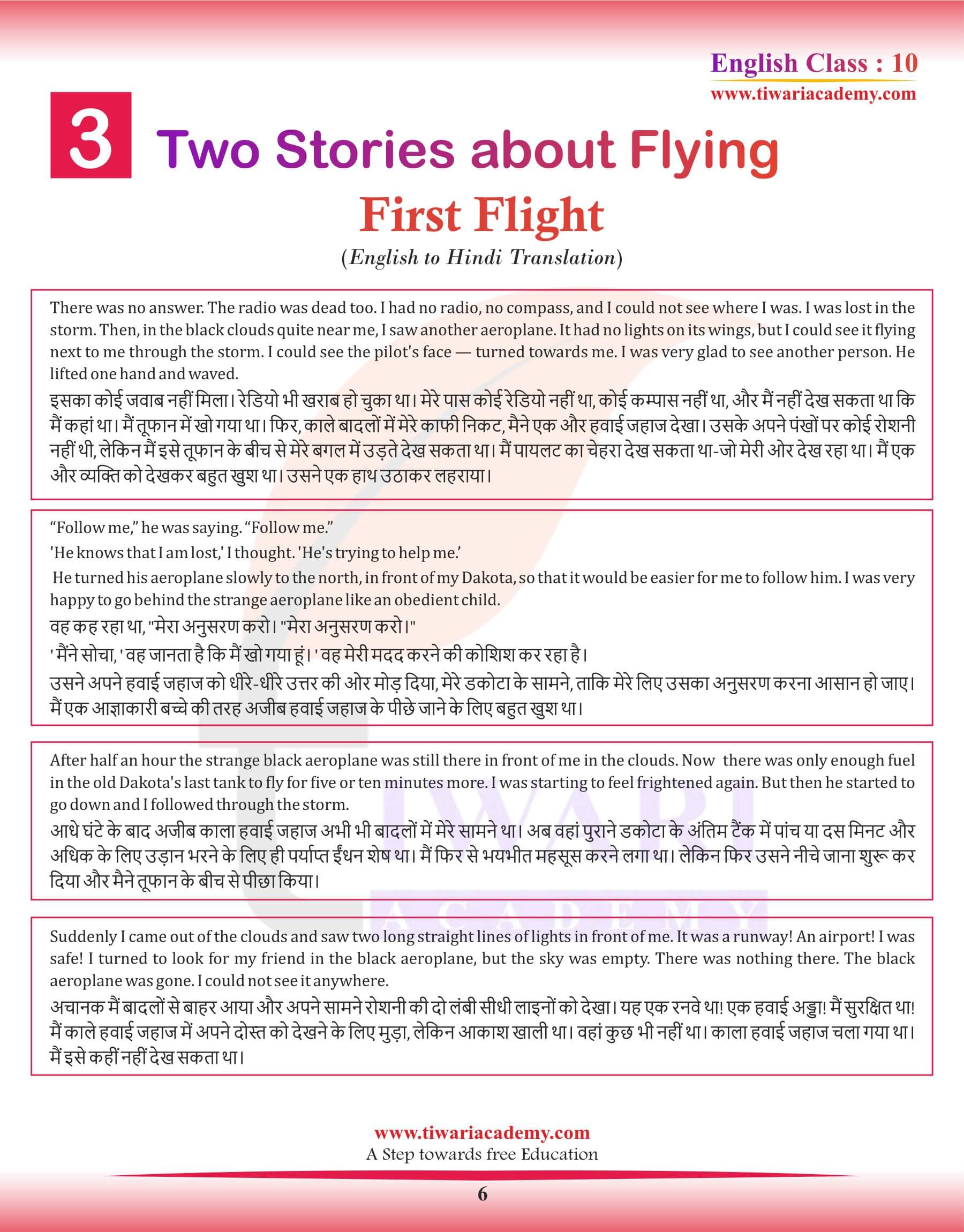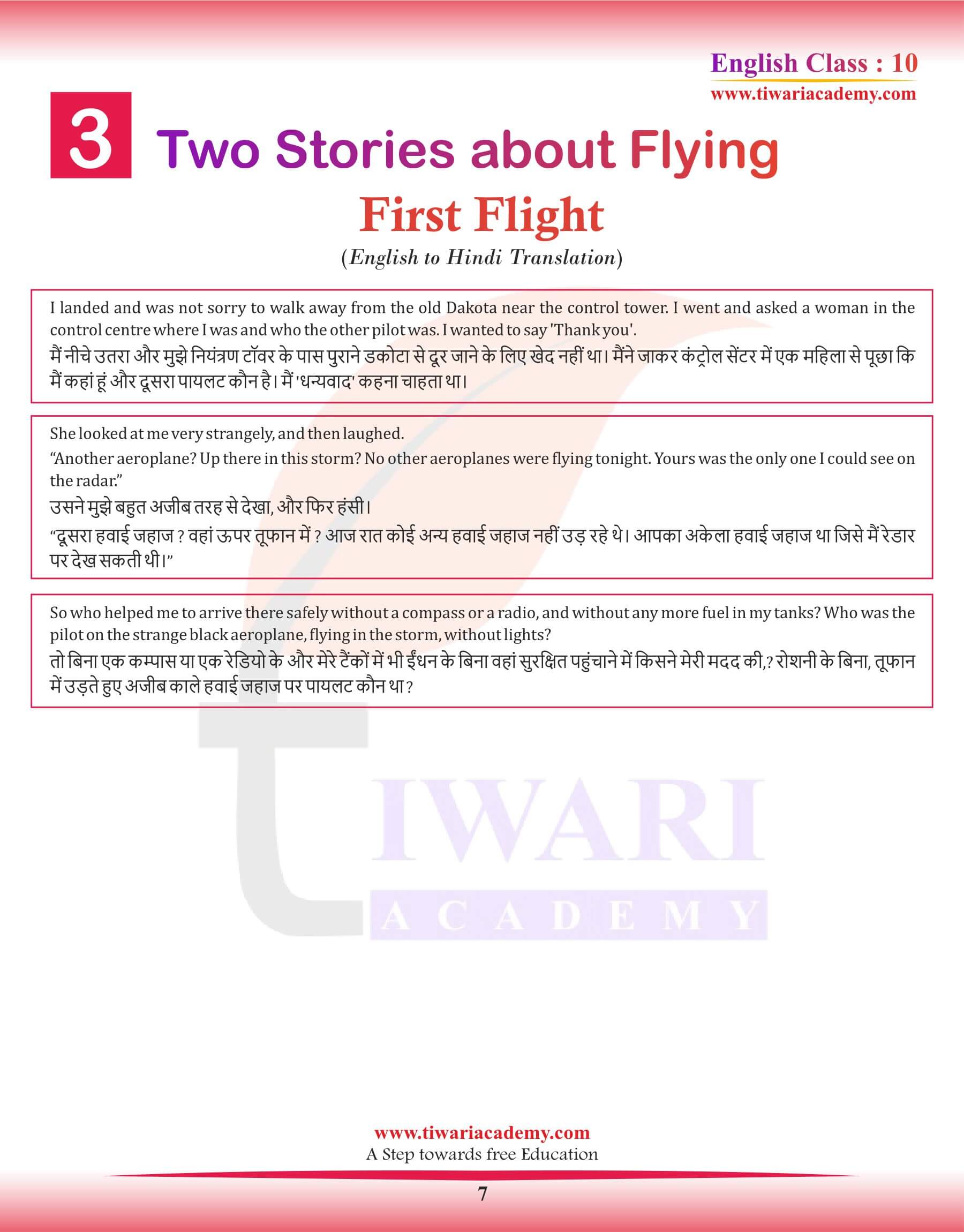Question Wise Class 10 English Chapter 3 Solutions
10th English Chapter 3 Question Answers
10th English Poem How to tell Wild Animals
10th English Poem The Ball Poem
10th English Chapter 3 Summary
10th English Chapter 3 MCQ
10th English First Flight Chapter 3 Translation
10th English Solutions Page
NCERT Solutions for Class 10 English First Flight Chapter 3 Two Stories about Flying and poems How to tell Wild Animals Hindi Translation and the Ball Poem with Summery. Class 10 English Solutions are aligned with the CBSE syllabus. This means that by studying the Tiwari Academy NCERT Solutions, students can be sure that they are covering all of the important topics that will be on their exams. Class 10 English chapter 3 is revised and modified according to NCERT books published for academic session 2025-26.
| Class: 10 | English |
| Textbook: | First Flight |
| Chapter 3: | Two Stories about Flying |
| Content: | Answers, Translation and Summery |
| Session: | Academic Year 2025-26 |
| Content Type: | Text, Videos and PDF Format |
Class 10 English Chapter 3 Question Answers
- Class 10 English Chapter 3 Two Stories about Flying
- Class 10 English Poem How to tell Wild Animals
- Class 10 English Poem The Ball Poem
- Class 10 English Chapter 3 Summary in Hindi and English
- Class 10 English Chapter 3 MCQ
- Class 10 English First Flight Chapter 3 Hindi Translation
- Class 10 English Solutions Main Page
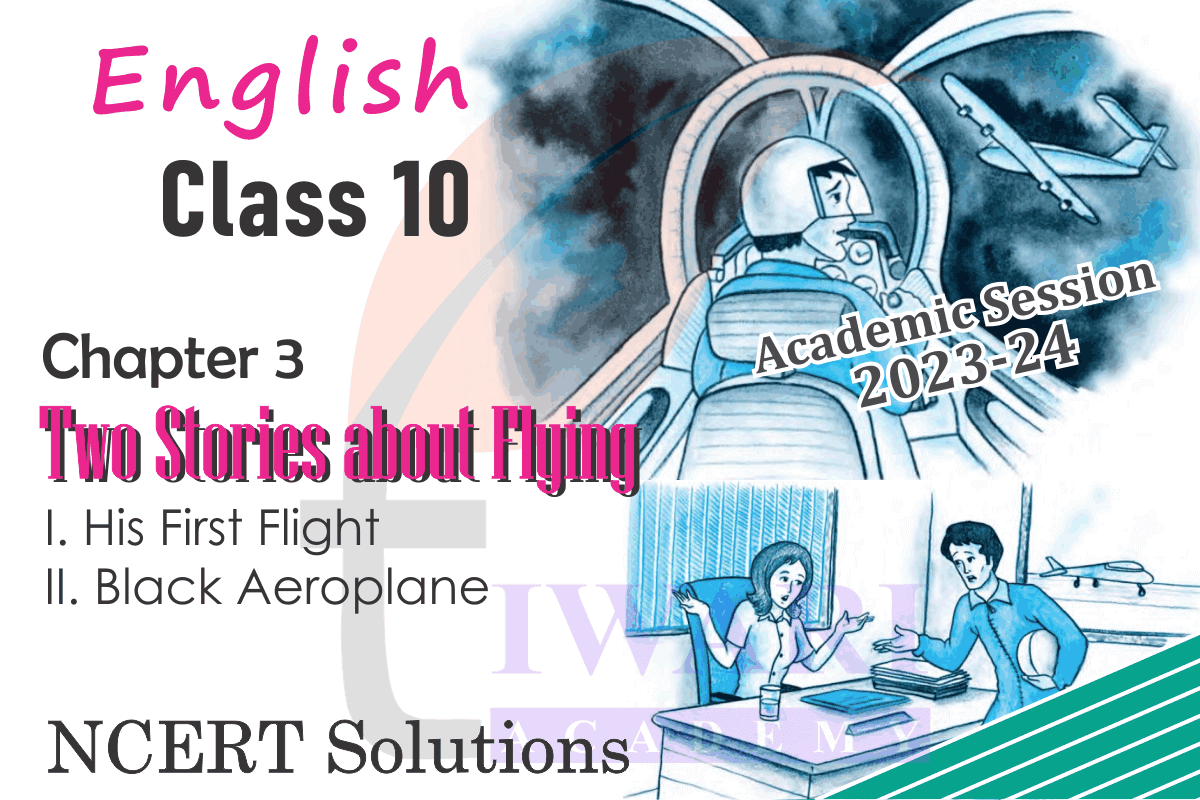
Grade X English 3rd Lesson and Poem, the answers are updated according to latest CBSE Board Syllabus 2025-26. 10th English chapter 3 solutions include all answers of oral comprehension check, working with the text, working with language, speaking and writing skills, etc. Download Offline Apps based on updated NCERT Solutions.
NCERT Solutions for Class 10 English First Flight Chapter 3
10th English First Flight Chapter 3 Question – Answers
NCERT Solutions for Class 10 English First Flight Chapter 3 Two Stories about Flying is given here with all questions answers with chapter end exercises. Download NCERT Solutions Offline Apps for class 10 English, which works even without internet.
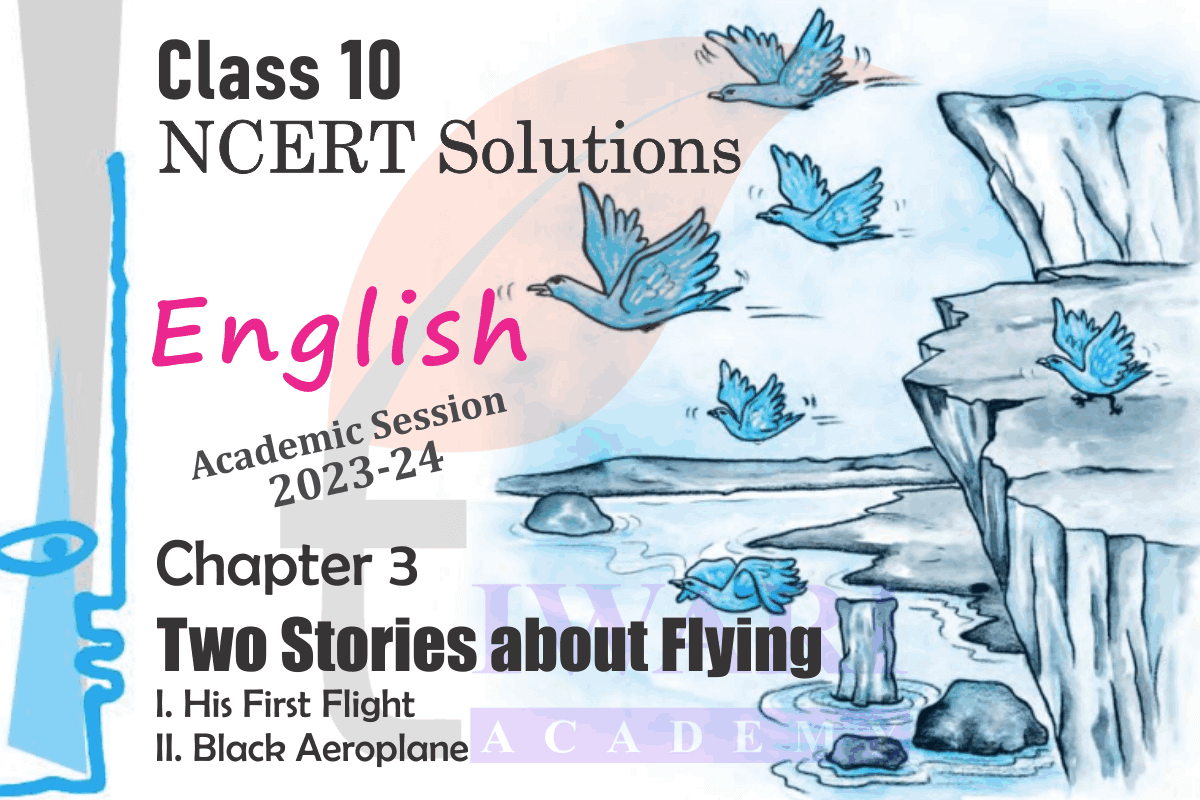
Passages for Comprehension
I. READ THE FOLLOWING PASSAGE AND ANSWER THE QUESTIONS THAT FOLLOWS:
The young seagull was alone on his ledge. His two brothers and his sister had already flown away the day before. He had been afraid to fly with them. Somehow when he had taken a little run forward to the brink of the ledge and attempted to flap his wings he became afraid. The great expanse of sea stretched down beneath, and it was such a long way down — miles down.
Questions:
1. Where was the seagull standing?
2. What was stretched beneath the seagull?
3. Find a word from the passage that means ‘spread’.
II. READ THE FOLLOWING PASSAGE AND ANSWER THE QUESTIONS THAT FOLLOWS:
Only his mother was looking at him. She was standing on a little high hump on the plateau, her white breast thrust forward. Now and again, she tore at a piece of fish that lay at her feet and then scrapped each side of her beak on the rock. The sight of the food maddened him. How he loved to tear food that way, scrapping his beak now and again to whet it.
Questions:
1. Who is ‘him’ here?
2. Why did mother tear at piece of fish?
3. Find a word from the passage which means ‘to sharpen’.
III. READ THE FOLLOWING PASSAGE AND ANSWER THE QUESTIONS THAT FOLLOWS:
But when she was just opposite to him, she halted, her wings motionless, the piece of fish in her beak almost within reach of his beak. He waited a moment in surprise, wondering why she did not come nearer, and then, maddened by hunger, he dived at the fish. With a loud scream he fell outwards and downwards into space. Then a monstrous terror seized him and his heart stood still. He could hear nothing. But it only lasted a minute.
Questions:
1. What was there in the beak of his mother?
2. What wondered the young seagull?
3. What was his state of mind?
Suggested Answers of Passages
Comprehension Passage I – Answers
1. The seagull was standing on his ledge.
2. Beneath the seagull a great expanse of sea was stretched.
3. Stretch.
Comprehension Passage II – Answers
1. Here ‘him’ refers to young seagull.
2. Mother tore at piece of fish to encourage young seagull to fly.
3. Whet.
Class 10 English First Flight Chapter 3 – Important Questions
Why was the young seagull afraid to fly? Do you think all young birds are afraid to make their first flight, or are some birds more timid than others? Do you think a human baby also finds it a challenge to take its first steps?
The young seagull was all alone on the ledge and afraid to fly because it was its first flight. Doing something for the first time is a challenging task in itself for anyone. Therefore, all young birds must be afraid to make their first flights the same way a human baby would finds it challenging to take its first step.
“The sight of the food maddened him.” What does this suggest? What compelled the young seagull to finally fly?
The young seagull was very hungry. The hunger ultimately compelled the young seagull to make its first flight. He saw its mother tearing at a piece of fish that lay at her feet and its hunger only intensified. It cried to its mother, begging her to get some food. Whenever its mother came towards it with some food in her beak, the young seagull screamed with joy and anticipation, but she stopped midway. The young seagull wondered why she did not come nearer. Unable to resist or control its hunger any longer, it dived at the food in its mother’s beak. For that moment, his hunger had overpowered the fear of the great expanse of sea beneath the cliff. Finally, this plunge was followed by the natural reaction of its body, which was to fly.
“They were beckoning to him, calling shrilly.” Why did the seagull’s father and mother threaten him and cajole him to fly?
The young seagull was frightened. It was afraid to fly. Even though it saw its parents helping and teaching its brothers and sisters flying, it could never gather enough courage to make the first flight. This was the reason why its father and mother were calling to it shrilly and scolding it. They threatened to let it starve on its ledge if it did not fly. They did so because they wanted it to leave its fear behind and learn the art of flying.
Have you ever had a similar experience, where your parents encouraged you to do something that you were too scared to try? Discuss this in pairs or groups.
One feels scared in learning any adventurous activity. It is because one has never come across such thing earlier. In learning one requires skill. During my childhood, I was much afraid to swim in the river. Though my elder brother tried to encourage me time and again. We both went to the river and he taught me how to move the legs and push the water through the hands by keeping mouth above the water level. In the beginning, I failed to do but gradually after day’s practice I became perfect in it.
In the case of a bird flying, it seems a natural act, and a foregone conclusion that it should succeed. In the examples you have given in answer to the previous question, was your success guaranteed, or was it important for you to try, regardless of a possibility of failure?
A bird flying is natural as well as taught to the young ones by their parents or their elder ones. So, one has to learn it through some of the properties which may breed in them naturally. Without any attempt and learning, nothing comes automatically. But it can be concluded that it should succeed. Our success was never guaranteed until to try again and again. In some cases, all results may not be favourable. But it is always essential to practice, try and put every efforts to get success.
“I’ll take the risk.” What is the risk? Why does the narrator take it?
The narrator was flying the old Dakota towards Paris. He saw storm clouds looking like black mountains. He knew he could not fly over them nor he had the fuel to fly around to north or south. The risk was to fly through the black storm clouds. The narrator took the risk because he wanted to reach Paris to celebrate Christmas with his family.
Describe the narrator’s experience as he flew the aeroplane into the storm.
As the narrator flew into the storm, everything went black. It became almost impossible to see anything outside the plane. The aeroplane jumped and twisted in the air. When he looked at his compass, he couldn’t believe what he saw. The compass was turning round and round. It was dead. Along with it, the other instruments, including the radio, were also dead. He saw another aeroplane with no lights on its wings, but was flying through the storm. Its pilot waved at him, asking him to follow. He was glad to find help. It was the last fuel tank and there was only enough fuel to fly five or ten minutes. Then, the other pilot started to go down and he followed. He suddenly came out of the clouds and saw the runway, on which he then landed his plane safely.
Why does the narrator say, “I landed and was not sorry to walk away from the old Dakota…”?
The pilot was delighted to land safely out of dark stormy black clouds, therefore, he was not sorry to walk away for his plane. He felt bad, when he was not able to thank his guide, his mentor who saved him from the frightening situation, but he was so happy after landing that he didn’t feel sorry for not being able to thank the guide pilot.
What made the woman in the control centre look at the narrator strangely?
The Women in control centre was surprised when the narrator asked about the other aeroplane and its pilot. She was surprised because she did not see any other aeroplane on the radar.
Who do you think helped the narrator to reach safely? Discuss this among yourselves and give reasons for your answer.
According to me, it was the narrator’s own self that helped him through the storm. As the woman at the control centre saw only his plane on the radar, there was no other plane in the storm. The narrator might have been hallucinating. He was a good pilot, and it might have been his own self that came to his help.
Have you ever been alone or away from home during a thunderstorm? Narrate your experience in a paragraph.
On the last Monday, I was going to school form my house. It is situated about 7 kilometres. All of a sudden there came a sand storm full of dust. Gradually it became too violent to move about. I decided to stay under the roof of Tiwari Academy (an education institute). Very soon it turned very fierce and took away many roofs of huts in the open. It became dark with dust and sand. Nothing was visible in that atmosphere. The storm was trying to blow away the people, standing in the open. Many trees were uprooted. After an hour, it receded but I did not find my bicycle. Later on, it was seen on a tree. Many of the people lost their things in that storm.
Comprehension Passage III – Answers
1. His mother had a piece of fish in her beak.
2. The young seagull was wondered as to why his mother stopped in the way.
3. His mind was caught in terror. His heart to stand still.
What does this story of part I from unit 3 of class 10th First flight book tells about the baby seagull?
The story tells us about the first flight after growing up the seagull took. He was afraid but then when he has no other option to feed himself his mother helped him to get help and he feels from a great height and during his fall he learned how to spread his wings and take a long flight.
Who do you think was the inspiration for the seagull’s first flight in the story of 10th class English book story in unit 3 part 1?
I think hunger is the inspiration as he was afraid to fly when even younger seagulls started to fly but when he stopped getting food and cried for the food from his mother lured him to the edge of the cliff and he fell and discovered the flight.
What do you think about the language used in the unit 3 story of class 10th First flight book?
I think the language was fairly easy to understand the story even high school vocabulary wasn’t there but there are certain words for which the meanings are given on either side.
What do you think the story on the 2nd part of unit 3 from class 10th first flight?
I think the story is kind of suspense about a flight that was in the storm but it is bizarre that a flight met his old Dakota and rescued him but actually, no one saw that flight except him.
Do you think the story of part 2 in class 10th first flight’s unit 3 was interesting?
I think the story was gripping and we want to know more about that black airoplane which the old Dakota followed.
Do you think the story in unit 3 part 2nd from class 10th first flight was easy to understand?
I think the story was very interesting and written in easy language which made it easy to understand.
